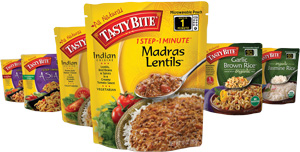I grew up in what was considered the Golden Age of this country. Times were simpler; everyone’s role was defined. Dad worked; my mom took care of the home. Dinner was at 6 p.m. Depending on the day of the week, you knew what meal would be served. Friday? Fish. Sunday? Pasta. Special occasions? Out to a restaurant: There was a steak house, certainly a bunch of Italian restaurants (none of which apparently could stack up to Grandma’s recipes), and if you really wanted to be exotic, there was Chinese.

|
|
No longer is it uncommon to see foods from other countries gracing American shelves. |
Now, in as much as the family dinner is a special and fading tradition (subject for a future discussion), what else about this time was so “golden?” Considering how that behavioral construct fits into today’s world, it occurs to me that there are only so many of Grandma’s meatballs you can eat before you just need some good sushi. But, of course, that’s because I’m a product of the times — and the times have changed.
Over the past thirty years, as Americans have begun dividing their time between the TV and the Web, and as the prevalence of two-income families has risen, we’ve become socialized to expect more and more and to get it faster and faster. We’ve been taught by media that races to us through high-speed internet and digital cable connections that the world is but a click away and, more significantly, that we don’t have to leave the comfort of our homes in order to develop an expanded pallet, which can be as sophisticated as we choose it to be. The cooking channel, for instance, and blogs, videos and social media sites like Pinterest and Facebook continually reinforce the idea that we deserve a broader range of healthier, better tasting and more sophisticated food options. The same neighborhood that in the past only offered steak, pasta and Chinese food today sports multiple options each for Indian, Thai, Greek and Japanese. And the pallet of the clientele is sophisticated enough to know the difference between the quality authentic and the knockoff.
At BRANDPACKAGING’s 2013 Packaging That Sells conference, Meera Vasudevan, co-founder, Preferred Brands International, spoke on Seeking Consumer Convergence Through Packaging, Megatrends and Market Research — and identified the three megatrends that propelled Tasty Bite into its recent launch of a new Asian-themed line of all-natural, 60-second heat-and-eat noodles. In her speech, Vasudevan cited trends which reflected consumers’ desire for natural/healthy foods, speedy and convenient meal options, and a wide range of ethnic/specialty foods.
In 2012, when Vasudevan and Preferred Brands contracted us to develop a new branding system for Tasty Bite, we were quick to agree with their hypothesis. Understanding that American consumers were using a staggering average of 40 spices per year while they struggled to easily and inexpensively increase their range of dining options, and that authentic regional foods from around the world were emerging as the norm rather than the exception, we found Tasty Bite’s positioning to be sound. We knew that we needed to present Tasty Bite as a delicious, authentic and special experience of international flavors that weren’t the “same old, same old.” Moreover, we hypothesized that three additional trends supported the brand’s successful launch into new territory — so that, in total, six current consumer trends supported the new launch.
- Consumers’ desire for natural/healthy foods
- Consumers’ desire for speedy and convenient meal options
- Consumers’ desire for a wide range of ethnic/specialty foods
- Consumers’ need for easy customization options to keep everyone happy
- Consumers’ desire to “know the source” of their food
- Consumers’ desire to feel like they were making a difference with their purchases
Tasty Bite’s two-serving pouches, for instance, support the customization trend and allow empty nesters, multi-generational units and single-person families alike to have a wide variety of choices at mealtime — choices which promise ingredients from Tasty Bite’s own socially conscious farming community, thus aligning with two other consumer trends: knowing the source of one’s food and wanting to improve the world with one’s purchase.
Today, at the onset of 2014, the expanded Tasty Bite line sits on the shelf: refreshed and communicating great taste appeal, discernible quality and easy, quick preparation. It does so while appealing to mainstream consumers searching for more sophisticated flavors and food experiences.
So, thanks to trend-conscious brands, today’s consumers can have the best of every world. They can have real, healthy, natural food products; they can have a wide variety of tastes and flavors; they can have ease of use and preparation, and they can have the confidence that they are building a better world, one bite at a time.
And a quick note to Grandma: I’ll always love your slow-cooked meatballs, but I’ve got a meeting to get to, and I’m really in the mood for some Tandoori chicken.

